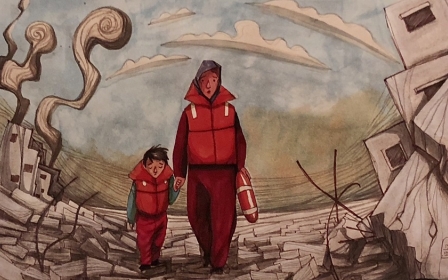Big in Japan: From jobless artist to origami king of Gaza
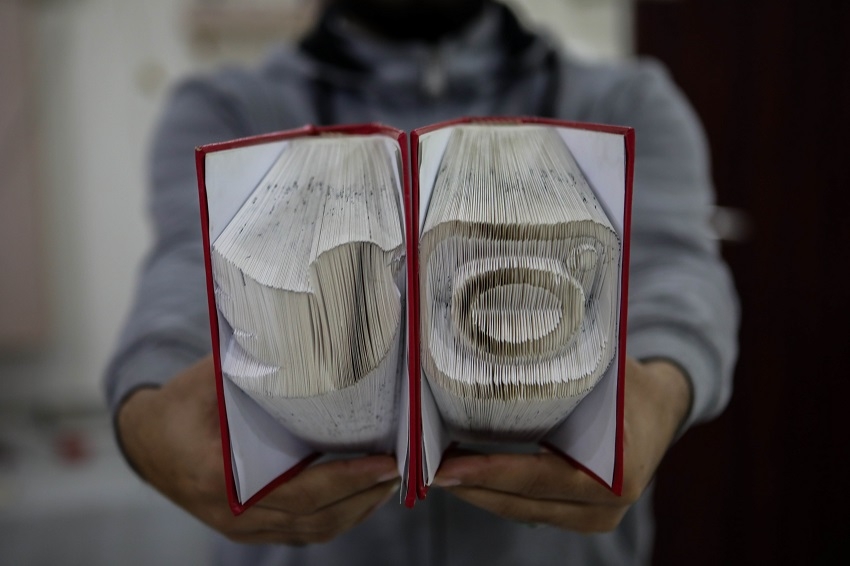
GAZA STRIP – In the densely-populated coastal enclave, where more than half the population is unemployed, Ahmed Hmeid, a Palestinian artist from the Nussairat refugee camp, knew he needed to break new ground in order to make a living.
The 29-year-old, who used to practise graffiti regularly, became familiar with origami through the internet, and soon it became his source of living. "Art, and especially drawing, has always been my passion. I used to spend hours on Instagram every day checking posts with new and creative graffiti ideas," Hmeid told Middle East Eye.
"One day while I was going through some graffiti accounts, I came across a picture that showed paper folded in a beautiful way to create a shape. I did not know back then the name of this art, so I just saved the picture but could not stop thinking about it."

Mesmerised by this art that was new to him, Hmeid set out to discover everything he could about its origins.
New MEE newsletter: Jerusalem Dispatch
Sign up to get the latest insights and analysis on Israel-Palestine, alongside Turkey Unpacked and other MEE newsletters
"I did not find other similar pictures at first because I could not search for the art when I did not even know its name," he said. "So I showed the picture to a friend of mine who told me that it is called origami and that it is originally a Japanese art form, and this is when my journey started."
Origami, the ancient Japanese art of paper-folding, is widely practised by many facets of society including children, youth, and the elderly.
"I spent five months just researching about origami and learning how it is created, and then another year practising it until I reached a point where I could say I had mastered it," he continued.
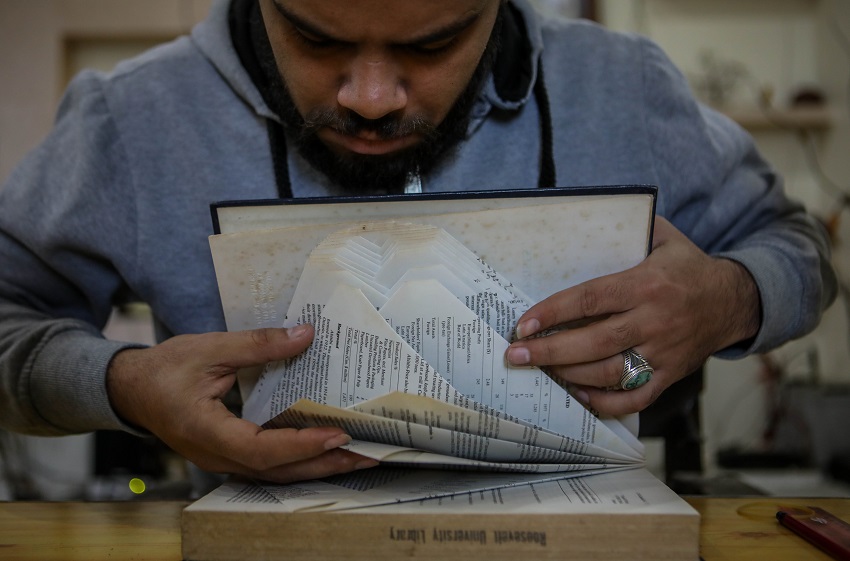
"Unlike common origami artists who create shapes using paper, I usually use whole books to create one name or symbol. It is not easy and it costs a lot more, but it creates such unique shapes and people love it."
A unique source of living
After graduating from high school in 2007 and choosing not to attend university, Hmeid was faced with the reality that it was nearly impossible for him to get a job, where even someone with a bachelor’s or master’s degree is challenged in finding work in Gaza.
"I grew up in a poor family and we could barely meet our basic needs. This has encouraged me to look for new sources of living," he said. "As you know, it is not easy to find a job here, especially when you do not have a college degree, but I did my best to find an alternative."
According to the World Bank, the unemployment rate in the Gaza Strip jumped to 53.7 percent in the second quarter of 2018, while it has exceeded 70 percent amongst youth.
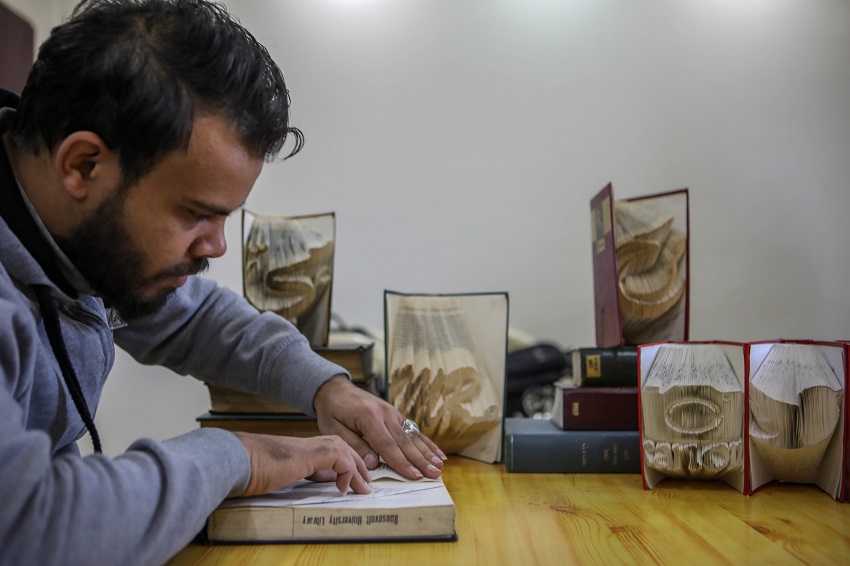
But Hmeid remained determined and did not give up as he knew he had to find a way to challenge the rampant unemployment.
"It all started last September when a young lady from Gaza who owns a handmade gift shop heard from some colleagues that I created origami art. So she contacted me and asked me to make a piece with her name, Hayat (Arabic for life) on it," he recalled.
'She paid me 100 Shekels and I was astonished someone would pay this much for paper art'
"I created her name using an old book and took it as a gift to her shop. When she saw it, she did not stop talking about how perfectly done it was and she offered to pay me for it.”
Although Hmeid refused payment for the gift, Hayat insisted that he deserved a reward.
"She paid me 100 Shekels ($27) and I was astonished someone would pay this much for paper art," he added. "She offered to post it on Instagram and I asked her to tag my account as part of advertising for my new business, and this is how people started to know about my art."

In order to create new works of origami art using books, Hmeid reached out to friends on social media for old and worn books.
"In only one day after I asked for books, 18 people offered me a lot of books for free, but I refused them all except for two," he said.
"The other 16 were all good Arabic books that could be very useful, but this was not what I wanted. I did not want to ruin books for art, I only accepted the ones that were very worn and useless."
Since starting last year, Hmeid has created more than 50 pieces using books to reflect the classic culture of origami with a modern touch.
"I sold a lot of pieces and people loved them. However, I still cannot depend on origami alone for a living, especially during this period when people can hardly secure their basic needs."
‘The border is an obstacle, again’
Hmeid’s social media presence has attracted local and international followers, such as Japanese origami artist, Hanklay, who admires Hmeid’s work and has been supportive by encouraging him and giving advice.
"The art captured his attention as I managed to create a new version of origami, one that is originally Japanese, well-known in Europe, and with Arabic letters," Hmeid said. "He soon suggested that we organise a joint exhibition in Japan where he uses the Japanese language and I use the Arabic one - but the border is an obstacle, again."
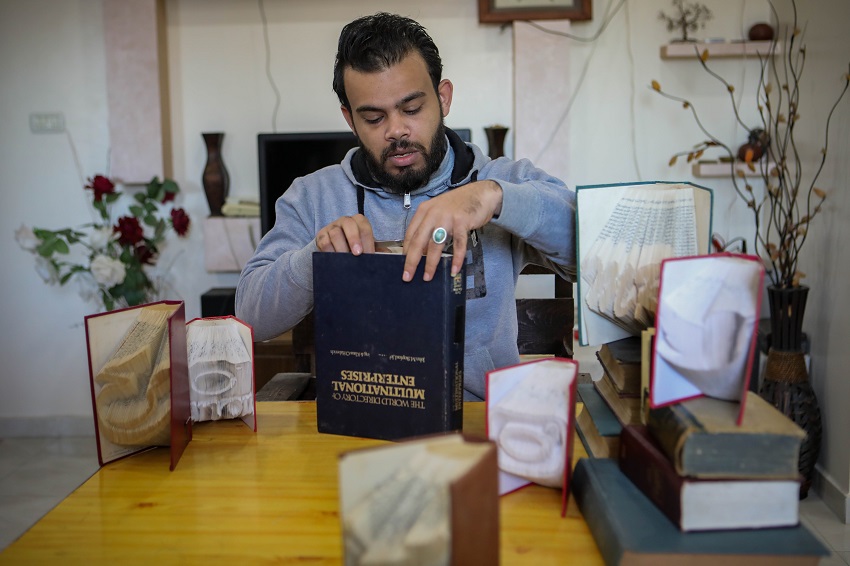
Since 2006, after Hamas won legislative elections, Israel has imposed a crippling blockade on the Gaza Strip. Residents face tight restrictions on movement in and out of the territory. Egypt also enforces the siege at the Rafah border.
"Like any other person who is proud of what he has achieved, I would certainly want to travel the world and show my talent to everyone," Hmeid said. "I want to represent my country and talk about the challenges I had to go through in order to be where I am today, but I simply cannot travel.
'I want to represent my country and talk about the challenges I had to go through in order to be where I am today, but I simply cannot travel'
"A lot of people abroad and also in the West Bank and Jerusalem see my art on social media and send me messages asking if I can make them special order pieces," he said. "I sadly apologise since I cannot deliver their orders due to the restrictions on movement on both the Erez and Rafah borders."
Hmeid still has hope that one day he will put on his own exhibition and represent his country.
"I cannot give up on my talent now after all that I have gone through. If they close the borders I will organise my exhibition here, in Gaza, and my art will reflect the suffering."
This article is available in French on Middle East Eye French edition.
Middle East Eye delivers independent and unrivalled coverage and analysis of the Middle East, North Africa and beyond. To learn more about republishing this content and the associated fees, please fill out this form. More about MEE can be found here.




